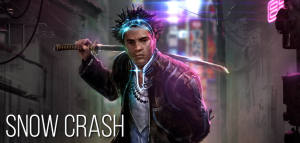Join Our Telegram channel to stay up to date on breaking news coverage
One of Web3’s most influential texts, Snow Crash, made many predictions, but it did not capture the current atmosphere of speculative activity around NFTs. No one in Neal Stephenson’s book is seen selling avatars for a profit like an NFT trader could on the OpenSea or Blur markets.
But Stephenson wasn’t necessarily incorrect. According to Stephenson, there will eventually be a move away from the sheer financialization of digital assets. This fundamental shift is necessary to create a thriving metaverse in which people assign value to digital assets above and beyond what they might be sold for.
In his words,
I’m hopeful that we can kind of shift away from this sort of single-minded attempt to financialize everything and start trying to establish a more varied economy, that by virtue, would be a more stable economy.
The word “metaverse” was first used in Neal Stephenson’s 1992 science fiction book, which described it as a 3D virtual world where many individuals interact with and own objects. Young people attend the “computer-games area of the neighborhood WalMart” to buy starting avatars that are generic and inexpensive, similar to cheap pairs of shoes. In the novel, the metaverse is also a well-known social scene that is filled with status markers of consumer life.
NFTs are not currently being sold at WalMart, but there are many characteristics of the novel’s ownership and identity systems that are similar to those of the current digital asset market. Virtual avatars can be hired, owned, or created from scratch in Stephenson’s metaverse, similar to how certain NFTs are built as profile images and used to represent parts of one’s digital existence online.
Yet, he claims that the absence of sentimental value creates circumstances in which whole NFT collections may be traded in a flash, adding to the erratic nature of the pricing of digital assets. He compared digital assets to “Tulip Mania,” a historical speculative bubble that occurred in Holland during the 17th century.
At the smallest indication that the market may be declining, he claimed, people are ready to throw all they have onto the market. “There’s no sentimental value that would even somewhat prevent you from selling them off if you believed their worth was going to decline.”
In order to foster sentimental value and prevent speculation, he said that owners of digital assets should be given some control over the assets they possess. He made this claim by claiming that a personal link would balance people’s impulses to make a profit.
With reference to user-generated content, Stephenson remarked,
The way that we achieve a stable economy in the metaverse is by offering chances for individuals to develop unique pieces of UGC. They could still attempt to sell them one day, but it’s unlikely.
Stephenson gave the example of a base he and his pals constructed together in the survival game Valheim. He claimed that even if the building could be sold, the experience of building and residing there would probably prevent him and his companions from doing so.
We produce that type of scarcity when we explore virtual worlds and develop things, he explained.
In essence, channels that enable individuals to forge stronger bonds with their digital assets will transform them from being purely financial investments to becoming personal objects. According to Stephenson, the same kind of value may be placed on something that is essentially useless, like a paperback book that is 30 years old and shows indications of wear and tear.
It has a lot of intangible connections that, in his words, are worth more to him than the item’s actual economic value.
I remember purchasing it, reading it, and highlighting the pages. I lent it to a buddy, and he returned it to me.
Even though the book was similar to another when it was purchased, Stephenson claimed that it seems really unique because of those personal experiences.
On one level, he said, it is not at all rare since there are many like it. Yet because it’s mine and the only one of its type, it’s precious and highly rare on another level.
Related
- OpenSea is surpassed by Blur as Ethereum NFT trading soars
- Blur NFT Airdrop & $BLUR Price Prediction – Best Crypto to Buy Now?
- DeFi and NFTs
Join Our Telegram channel to stay up to date on breaking news coverage


